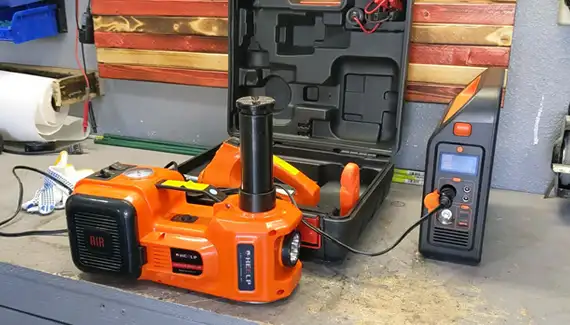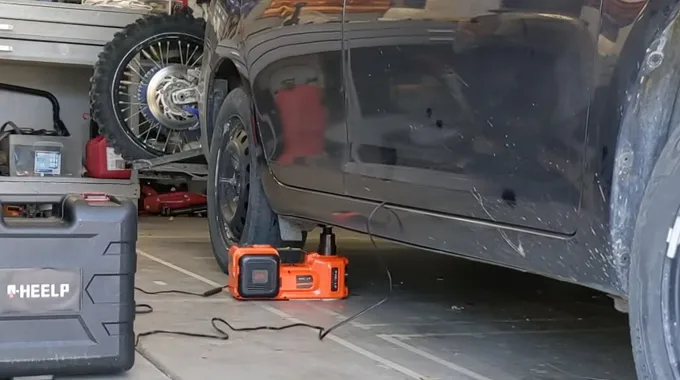Last Updated on March 19, 2023
In any vehicle owner’s toolbox, an electric jack is essential in protecting, maintaining, and servicing their vehicle. Unfortunately, a faulty power jack can threaten that safety, from potential vehicular damage to personal harm such as fire hazards or electric shocks.
So if you struggle with the electric jack malfunctioning, why not take some time today to identify what could be causing this issue?
Electric jacks can be vulnerable to various issues, from failing batteries and blown fuses to wiring shorts or faulty switches. Even veteran car owners could find their vehicle compromised if one of these components fails.
That’s why you must keep your electric jack in proper condition to stay safe on the road. Here we will discuss the most common causes of power jack malfunctions, how to fix them, and a few safety tips.
Possible Causes of Your Electric Jack Not Working and Solutions

If your electric jack isn’t working correctly, there could be a few underlying causes. Here are a few of the most common issues with electric jacks and their respective solutions:
Number 01: Dead Battery
A dead battery is one of the possible causes of an electric jack not working. This can be due to various factors, such as a lack of charge over time, leaving the electric jack unused for long periods, or simply a low-quality battery that has lost its charge.
In any case, the first step in diagnosing this issue is to check the terminals on your battery. If they appear corroded or dirty, then it is likely that your battery is not transmitting enough power to your electric jack and needs to be cleaned or replaced.
It’s also essential to ensure that the battery is fully charged and that there are no visible signs of damage or wear and tear.
The solution for this cause is fairly straightforward. Replacing or recharging the battery should restore power to your electric jack if it was only due to a lack of charge.
Suppose you are unable to do so yourself. In that case, you may need to take it to a professional mechanic who can diagnose and repair any issues with your vehicle’s electrical system.
Number 02: Blown Fuse
Another potential issue with an electric jack not working could be a blown fuse in your vehicle’s cab or under its hood. Generally speaking, fuses are designed as sacrificial components to protect other components from being damaged by excess current running through them.
When too much current passes through them, they “blow.” It means they cease functioning and must be replaced for power flow to resume.
To diagnose whether this is the issue with your electric jack, you will need access either under your car’s hood or inside its cab. Here you will find fuses along various points throughout both areas, which control different circuits within the vehicle, including those powering your electric jack.
If one appears visibly broken (usually indicated by metal connectors coming apart), it needs replacing before electrical flow can resume through that circuit. Thus restoring power back into your electric jack.
Number 03: Loose Connection
If these two, then another reason an electric jack may not be working could be due to loose connections between components such as cables, plugs, etc.
Any breakage or disconnection along these lines means that the flow of electricity cannot continue further down, thereby leading to a lack of power coming out of the other end (e.g., at the electric jack).
To fix this issue, you must inspect each component within this particular circuit. Checking for frayed wires amongst plugs/sockets etc., which have come undone over time.
Fix these wherever necessary until they are making proper contact again (this may require some soldering depending on where/what type of connection has become disconnected).
Once all connections have been appropriately secured and tested again, hopefully, you will notice restored electrical power once again.
Number 04: Bad Switch or Short in the Wiring
A bad switch can be caused by factors from wear and tear to exposure to the elements. In such cases, replacing the switch is usually required. Similarly, a short in the wiring can also cause an electric jack to fail, as this will prevent adequate power from reaching the components that need it.
To check for a short in the wiring, use an ohmmeter to test the continuity between two points on the circuit. If there is none, then a short exists and needs to be addressed accordingly.
Solutions include replacing faulty wires or securing them with additional insulation or electrical tape. Properly splicing wires may also be necessary if they have been cut too close together during installation.
Number 05: Motors Can Go Bad
Electric jacks are powered by motors which can also be some of their more vulnerable components. Over time, heavy use and exposure to moisture can cause these motors to fail due to corrosion and the breakdown of internal parts such as brushes and coils.
As with switches, replacements for these parts are needed when they go bad. Although, depending on their age and condition, sometimes simply cleaning them is enough to get them working again.
Also, checking voltage across motor terminals while operating will help you identify any inconsistencies that may indicate a failing motor or other underlying issues within your electric jack assembly.
Number 06: The Ground Connection Might Also Fail
The ground connection is often overlooked when troubleshooting electric jacks. Still, it can play an essential role in its operation. Mainly since it provides an escape route for unwanted electrical charges that could damage other components within your jack assembly if left unchecked.
To test whether or not your ground connection is still intact requires removing both ends of it and using an ohmmeter once again to measure continuity between both points.
If there’s no current flowing through, then chances are your ground connection has gone wrong and needs replacing as soon as possible before further damage ensues elsewhere inside your assembly.
In some cases, this issue could even require re-running a new ground wire from the start (the battery) all the way back to the end (the jack).
Can Every Electric Jack Be Raised Manually If It Doesn’t Work?

Regarding electric jacks, not all models have a manual override feature. If the motor or switch malfunctions, it may be impossible to raise or lower the jack manually.
But, many models do offer this feature, allowing users to crank the jack into position in the event of an electrical problem. This can be a reassuring feature when purchasing an electric jack, as it provides reassurance that you can access your vehicle even if something goes wrong.
When shopping for an electric jack, always ensure it has a removable hand crank for manual operation. Doing so can save you time and trouble if your electrical system fails.
How Do You Manually Raise If an Electric Jack Does Not Work?
To manually raise an electric jack when it is not functioning correctly, you will need access to the manual override slot, which should be located at some point along the base of the jack.
Insert a hand crank into this slot and turn clockwise to raise and counterclockwise to lower until the desired height is reached. Once finished, remove and store away the hand crank, so it is ready for future use.
When you need to lower the jack again, re-insert the hand crank and turn it counterclockwise until you reach the desired height. Then remove the crank and store it away for future use.
Do I Need To Cover My Electric Tongue Jack to Prevent Malfunctions?
A critical element of keeping your electric tongue jack in working order is to protect it from the elements. Weather, UV light, and water can all lead to damage and malfunction if not prevented.
A great way to do this is by covering up your electric tongue jack with a jack cover when it’s not used. This cover will prevent water from getting into the casing or switches and keep UV light from degrading its performance over time.
Also, it will keep dirt and other particles out, possibly leading to problems. The cover should be made of a durable material resistant to water and wear and tear to remain secure while protecting the electric tongue jack.
How Do You Maintain an Electric Jack?

To ensure your electric tongue jack continues running smoothly, you must practice regular maintenance on it. This includes washing the jack with warm, soapy water and sanding off any rust buildup you may find on it.
After this step, apply a protective spray coating on the jack’s outside to protect it against weather and other environmental hazards. Furthermore, many jacks don’t require lubrication since oil can collect debris over time, causing damage instead of preventing it.
Unless specifically recommended by the manufacturer, you should avoid lubricating them anyway. Finally, always ensure all parts work before taking your RV out for a trip or storage.
Ensuring bolts are tight and wires are correctly connected goes a long way in ensuring proper operation of your electric tongue jack over time.
Protect Your Electric Jack from Malfunction and Damage
Taking proactive steps to identify any risks involved with your electric jack can significantly reduce the likelihood of a malfunction occurring and the frustration that comes along with it.
To avoid malfunctions, inspect your setup regularly and check for common issues like dead batteries, blown fuses, loose connections, bad switches or shorts in the wiring, or motors going bad. You can also consider covering the electric jack as an added precaution against damage caused by weather or debris.
Understandably, these tips may not always work, but they should help you troubleshoot and get your equipment running again with minimal stress and expense.
